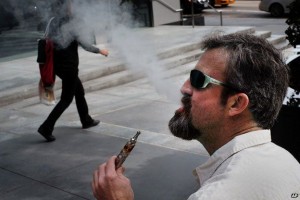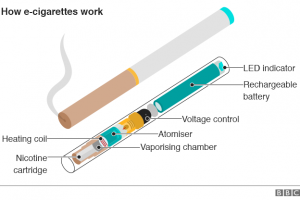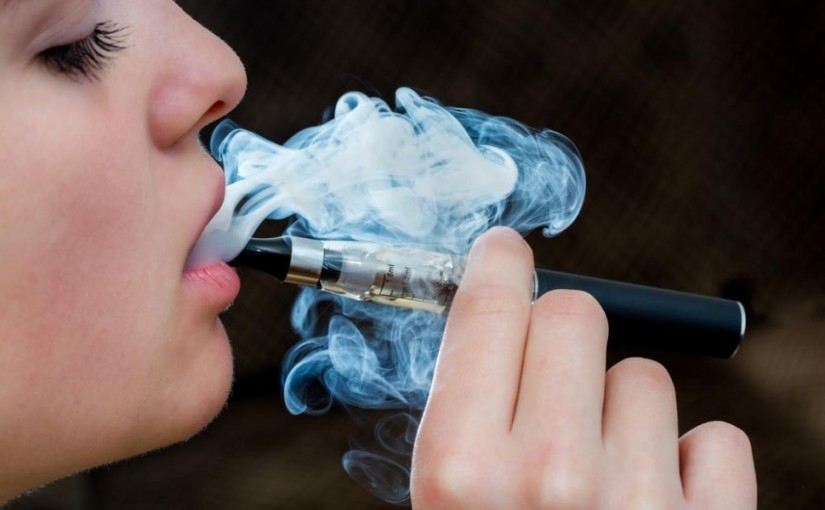Report: E-cigs overtake cigarettes in popularity among Utah teens
SALT LAKE CITY — Not long after he had his first cigarette at 14 years old, Braedon Elies had worked his way up to half a pack a day.
About 2 years ago, the 20-year-old St. George resident switched to e-cigarettes in an effort to quit smoking.
He hasn’t looked back since.
“I like the vapor,” Elies said. “A lot more comes out, tastes better, doesn’t stink up your clothes — there’s just a whole bunch of benefits to it.”
Despite Utah having some of the lowest rates of cigarette use in the nation, the e-cigarette craze — particularly among teens — hasn’t skipped the Beehive State. According to data released Monday by the Utah Department of Health, cigarettes have overtaken cigarettes in popularity among Utah teens for the first time.
Nearly 11 percent of Utah students in eighth, 10th and 12th grades reported using e-cigarettes in the past month — almost double the rate two years ago, when 5.8 percent of Utah students said they use e-cigarettes.
In contrast, just 3.4 percent reported smoking regular cigarettes in the past month.
Joseph Miner, executive director of the health department, said it was frustrating to see a product “reversing the successes” Utah had in reducing cigarette use.
“For some reason it’s not considered nearly as serious,” Miner said. “Youth and even retailers who sell these e-cigarettes don’t think it’s as big a problem as tobacco use. Therefore, sales are not very well-controlled.”
Proponents of vaping say the practice is safer than cigarettes because it doesn’t produce the carcinogenic tobacco smoke that kills 480,000 Americans every year.
But health officials warn that little is known about the long-term effects of e-cigarettes, which have been shown to produce small amounts of carcinogens and chemicals.
As e-cigarettes have exploded in popularity, the products have become sleeker and the advertising more glossy. Vape stores now sell the cartridges of e-juice, the concentrated liquid nicotine used in refillable vapes, in flavors such as cherry, cinnamon and cereal milk.
Vaping conventions and competitions have proliferated. And Elies and his girlfriend say they find a sense of community among fellow vapers, many of whom, like Elies, swear e-cigarettes have helped them cut back on smoking.
“It’s pretty crazy,” said Cara Jolley, Elies’ girlfriend. “People used to smoke hookah a lot more, and this has kind of almost replaced it in that sense because you do all these smoke tricks and the fun aspects of that while also not smoking cigarettes.”
But e-cigarettes haven’t been shown to be more effective than nicotine patches or gum at helping people quit smoking, according to Denitza Blagev, a pulmonologist at Intermountain Medical Center in Murray.
And it’s the popularity of e-cigarettes among young teens that worries her.
Although most health care providers agree e-cigarettes are likely safer than traditional cigarettes, studies that show that teens who use e-cigarettes are more likely to graduate to regular cigarette use, she said.
“The way those packages are advertised, they’re colorful, they’re flavored, they’re back to the early days of cigarettes where you have celebrities advertising it,” Blagev said.
Among Utah students who use e-cigarettes, 43 percent said they haven’t tried regular cigarettes, according to the health department report.
“If they were regulated the way we regulate any other (product) like nicotine patches and they weren’t being advertised as this cool thing kids should start, then we could say maybe it works for some people,” Blagev said. “But it’s really when you weigh that against teenagers starting smoking again that is really, really worrisome.”
Regulators have been scrambling to keep up with the exploding e-cigarette industry.
Last year, Salt Lake County Health Department officials collected samples of e-juice — the vials of liquid nicotine used in refillable vapes — from local stores. They found that 61 percent had either more or less nicotine content than advertised, with discrepancies ranging from 88 percent less to 840 percent more nicotine than labeled.
Even samples that were supposed to be nicotine free contained trace amounts of it.
The colorful e-juice or e-liquid cartridges usually aren’t childproof. That’s been a problem for poison control experts, according to Utah Poison Control Center Director Barbara Crouch.
In 2011, the Utah Poison Control Center responded to eight cases of exposure to e-juice.
In 2014, they responded to 133.
“Our biggest concern are the unintended victims, the very small children who get into these,” said Crouch, who said the majority of patients are children under age 6. “I think all of us fear tremendously for these products.”
In May, Utah passed legislation that bars sellers from advertising e-cigarettes as a tool to help quit smoking. The law also requires sellers to have a license to sell e-cigarette products.
Weber-Morgan Health Department Executive Director Brian Bennion said similar regulations enacted in Weber and Morgan counties, which have some of the highest rates of teen e-cigarette use in the state, are working well.
Bennion said use rates among teens had decreased from 20 percent to 15 percent after enacting the regulations.
As for Elies and his girlfriend, they support laws that will make it harder for underage kids to obtain e-cigarettes.
But they said they’ll continue to encourage friends to use e-cigarettes because they believe the benefits outweigh the potential health consequences.
“I think about it from time to time. I know it’s probably not the greatest thing to do,” Elies said. “But it’s obviously better than cigarettes.”
One day, he and Jolley hope to quit entirely.
But they’re not sure when that day will be. When asked how often he vapes, Elies laughs.
His reply: “All day, every day.”
Source : KSL


















